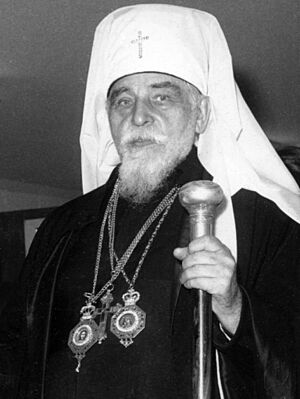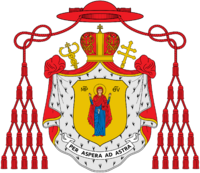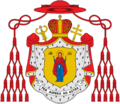Josyf Slipyj facts for kids
Quick facts for kids His Eminent Beatitude Josyf Slipyi |
|
|---|---|
| Cardinal, Metropolitan of Galicia Major Archbishop of Lviv |
|

Cardinal Slipyi in Australia in 1968
|
|
| Church | Ukrainian Greek Catholic Church |
| Appointed | 1 November 1944 |
| Enthroned | never |
| Reign ended | 7 September 1984 |
| Predecessor | Andrey Sheptytsky |
| Successor | Myroslav Lubachivsky |
| Orders | |
| Ordination | 30 September 1917 (Priest) |
| Consecration | 22 December 1939 (Bishop) by Andrey Sheptytsky |
| Created Cardinal | 22 February 1965 by Pope Paul VI |
| Personal details | |
| Birth name | Йосип Сліпий |
| Born | 17 February 1892 Zazdrist, Kingdom of Galicia and Lodomeria, Austria-Hungary (now Ukraine) |
| Died | 7 September 1984 (aged 92) Rome, Italy |
| Buried | St. George's Cathedral, Lviv 49°50′19.48″N 24°0′46.19″E / 49.8387444°N 24.0128306°E |
| Denomination | Catholicism |
| Motto | Per aspera ad astra |
| Coat of arms | |
Josyf Slipyi (Ukrainian: Йосиф Сліпий, born as Ukrainian: Йосиф Коберницький-Дичковський, romanized: Yosyf Kobernyts'kyy-Dychkovs'kyy; 17 February 1892 – 7 September 1984) was a very important leader of the Ukrainian Greek Catholic Church. He became a cardinal in the Catholic Church. He is remembered for his strong faith and for leading his church through very difficult times.
Contents
A Life of Faith and Leadership
Early Years and Education
Josyf Slipyi was born in a village called Zazdrist in what is now Ukraine. His family were farmers, not from a special religious background, which was unusual for priests at that time. He studied at schools in Ternopil and Lviv, and then at Innsbruck University in Austria. He became a priest on June 30, 1917. Later, he continued his studies in Rome, Italy, from 1920 to 1922.
After returning to Lviv, Josyf Slipyi became a professor of theology in 1922. Theology is the study of religious faith. In 1926, he became the head, or rector, of the seminary. He worked hard to improve the seminary and started a group for scholars called the Theological Academic Society. He also became an editor for a religious magazine. In 1929, he became the first rector of the Lviv Theological Academy, which was a very important step for Ukrainian Catholic education.
Leading the Church Through Hard Times
On December 22, 1939, Josyf Slipyi was secretly made an archbishop. This was done in secret because the Soviet Union had taken control of Western Ukraine, and the political situation was very tense. He became the head of the Ukrainian Greek Catholic Church on November 1, 1944, after the death of the previous leader, Metropolitan Andrey Sheptytsky.
Imprisonment by Soviet Authorities
In 1945, after Soviet troops took Lviv, Josyf Slipyi was arrested. Many other bishops were arrested too. This was part of a plan by the Soviet government to get rid of the Ukrainian Greek Catholic Church. He was accused of working with the Nazi regime, but this was a false charge. He was sent to a Gulag, which was a Soviet labor camp in Siberia.
While he was in prison, Soviet authorities forced the Ukrainian Greek Catholic Church to join the Russian Orthodox Church. Josyf Slipyi refused to give up his faith or his church. He was sentenced to more years in prison several times. He spent a total of 18 years in harsh labor camps in Siberia and Mordovia. He suffered greatly during this time, enduring illnesses and injuries. Despite this, he managed to write a history of the Catholic Church in Ukraine while in prison.
Freedom and New Leadership in Rome
On January 23, 1963, Josyf Slipyi was finally freed. This happened after leaders like Pope John XXIII and U.S. President John F. Kennedy put political pressure on the Soviet government. He arrived in Rome on February 9, 1963. He was able to take part in the Second Vatican Council, a major meeting of Catholic bishops from around the world.
Many Ukrainian bishops wanted Josyf Slipyi to be named a patriarch, which is a very high rank in the Church. However, Pope Paul VI decided to create a new title for him: major archbishop. Josyf Slipyi became the first person to hold this title on December 23, 1963.
| Styles of Josyf Slipyj |
|
|---|---|
 |
|
| Reference style | His Eminence |
| Spoken style | Your Eminence |
| Informal style | Cardinal |
| See | Kyiv and Halych |
On January 25, 1965, Pope Paul VI made him a cardinal. He was the fourth cardinal in the history of the Ukrainian Greek Catholic Church.
Reorganizing the Church
After his release, Cardinal Slipyi worked hard to organize and strengthen the Ukrainian Catholic Church from Rome. He traveled to many countries, including Europe, America, Asia, and Australia. He wanted to connect with Ukrainian communities living outside Ukraine and help their religious life grow.
He also held several important meetings, called synods, for the Ukrainian Greek Catholic Church. In Rome, he bought and rebuilt a church for Ukrainian Catholics. He also helped build the Santa Sofia Cathedral in Rome. He restarted religious publications and, in 1963, he founded the Ukrainian Catholic University of St. Clement.
Death and Legacy
Josyf Slipyi passed away in Rome on September 7, 1984. Even though he was not allowed to return to Ukraine by the Soviet leaders, he never gave up his Soviet passport. After the Soviet Union broke apart, his remains were brought back to Lviv, Ukraine, and reburied in St. George's Cathedral in August 1992.
His life was so inspiring that the process to declare him a saint has begun in Rome.
His Writings and Ideas
Josyf Slipyi was also a scholar. He wrote many books and articles about theology. He tried to connect traditional Catholic teachings with Eastern Christian thought. His writings covered topics like the Holy Trinity and Holy Sacraments. All of his works were collected and published in eight volumes between 1968 and 1976.
Honors and Commemoration
Honors and Awards
- He was made an honorable member of the Shevchenko Scientific Society in 1964.
- He became a member of the Tiberian Academy in Rome in 1965.
- He received an honorary doctorate from the Ukrainian Free University in Munich in 1969.
- The National Bank of Ukraine issued a special coin with his image.
Monuments and Memorials
- A monument of Cardinal Josyf Slipyi was unveiled in Chicago, USA, in 2009.
- In his home village of Zazdrist, a monument and a bust were installed in his honor.
- A monument dedicated to him was placed in front of the UGCC Cathedral in Ternopil in 2004.
- Commemorative plaques have been installed in Lviv and Kharkiv.
Museums and Institutions
- A museum dedicated to Josyf Slipyi opened in Lviv in 1997.
- The "Hometown" memorial museum complex was opened in his birth village, Zazdrist, in 1998.
- A seminary and a collegium in Ternopil are named after him.
- An elementary school in Toronto, Canada, is also named after him.
Streets and Events
Many streets in Ukrainian cities like Lviv, Ternopil, and Ivano-Frankivsk are named after Patriarch Josyf Slipyi.
In 2002, the Ukrainian Greek Catholic Church dedicated the year to celebrating the 110th anniversary of his birth. In 2012, the Ukrainian parliament ordered a national commemoration of his 120th birthday. They suggested republishing his works and holding a conference about his role in Ukrainian history. The National Bank of Ukraine was asked to issue a commemorative coin, and the postal service was asked to print stamps with his portrait.
The Shoes of the Fisherman
The life story of Josyf Slipyi, especially his imprisonment and release, might have inspired the 1963 novel The Shoes of the Fisherman by Australian writer Morris West. The book is about a Ukrainian archbishop who is freed from a Siberian labor camp and later becomes pope.
Even though the author said his characters were fictional, the similarities between the book's main character and Josyf Slipyi's life were very striking. The book became very popular and was even made into a Hollywood movie in 1968. Some people saw the story as a prediction because 15 years later, Pope John Paul II, the first Slavic pope from a Communist country, was elected.
Images for kids




